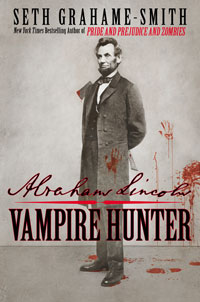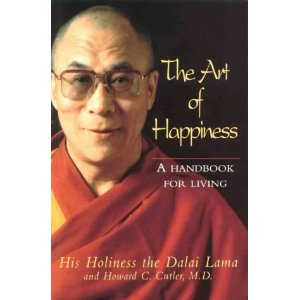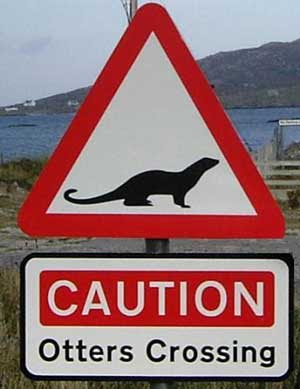Abraham Lincoln: Vampire Hunter

As If abolishing slavery weren't enough
So… I thought that Quirk Books had had its fun with literature. But no, Seth Grahame-Smith desecrates another poor helpless dead person again. This time, much more shamelessly, since this is actually Abraham Lincoln’s BIOGRAPHY. Come on. This guy wrote “The Big Book of Porn: A Penetrating Look at the World of Dirty Movies,” and “How to Survive a Horror Movie: All the Skills to Dodge the Kills.”
Don’t you think that the satirization of canonical historical figures and books has gone on long enough? I mean… sure, we have the Colbert Report. The Daily Show. The Onion. But ever since P& P& Zombies, there have been authors upon authors trying to scratch a bit of fame and nudge-nudge wink-wink humor and fame out of this trend. I mean, there’s humor, and then there’s just pure slapstick.
But there’s more. Mansfield Park and Mummies. Queen Victoria, Demon Hunter. The Undead World of Oz. Emma and the Werewolves. The War of the Worlds plus Blood, Guts, and Zombies. (very subtle) Android Karenina. Robin Hood & Friar Tuck: Zombie Killers – A Canterbury Tale (So many things wrong with this last one. First of all: Robin Hood & Friar Tuck were not killers. Lovers, not fighters, I say. And second, there is NO Robin Hood or Friar Tuck in the Canterbury Tales. Robin Hood is an invention of the Northern English imagination whereas Chaucer was a Londonite… AND he lived before the popularity of the Robin Hood legend)
I expose this as just a thinly veiled attempt for people to 1) convince other people that they’re cultured enough to have read the original 2) cultured enough to enjoy the original 3) cultured enough to take everything they read with irony.
So buy it. Put it on your bookshelf and laugh about it with your friends. Abraham Lincoln is watching.
NPR article here

 My husband and I were invited over to the home of another couple who we are great friends with (Todd and Amy) to make sushi together a few weeks ago. I keep forgetting to upload the photos, so, here they are! Finally! The fish and most of the fixins were purchased at Asian Delight Marketplace. I highly recommend that you stop in there and take a look around. They have everything there; meat, produce, ice cream and other frozen goods, and several aisles with just about every Asian grocery imaginable. The candy aisle alone is worth the trip. We also had some amazing sake that Todd picked up; Coconut Lemongrass by Moonstone. It was refreshing and mildly sweet.
My husband and I were invited over to the home of another couple who we are great friends with (Todd and Amy) to make sushi together a few weeks ago. I keep forgetting to upload the photos, so, here they are! Finally! The fish and most of the fixins were purchased at Asian Delight Marketplace. I highly recommend that you stop in there and take a look around. They have everything there; meat, produce, ice cream and other frozen goods, and several aisles with just about every Asian grocery imaginable. The candy aisle alone is worth the trip. We also had some amazing sake that Todd picked up; Coconut Lemongrass by Moonstone. It was refreshing and mildly sweet. from here.
from here. from here.
from here. “I see no hope for the future of our people if they are dependent on Frivolous youth of today, for certainly all youth are reckless beyond Words… When I was young, we were taught to be discreet and Respectful of elders, but the present youth are exceedingly wise disrespectful] and impatient of restraint”
“I see no hope for the future of our people if they are dependent on Frivolous youth of today, for certainly all youth are reckless beyond Words… When I was young, we were taught to be discreet and Respectful of elders, but the present youth are exceedingly wise disrespectful] and impatient of restraint”

 . This is certainly the The Pragmatic Programmer
. This is certainly the The Pragmatic Programmer for designers.
for designers. excerpts, but the idea is: sometimes you’ll have several people (stakeholders) to please, plus the user. How to make the tough call, or how to provide best solutions that fits them all? – If it looks like a duck and sounds like a duck, make it a duck… but how? The book helps on this.
excerpts, but the idea is: sometimes you’ll have several people (stakeholders) to please, plus the user. How to make the tough call, or how to provide best solutions that fits them all? – If it looks like a duck and sounds like a duck, make it a duck… but how? The book helps on this. The characters in this novel are all well conceived and complex. Liesel, the protagonist, is soft-hearted but tough and willingly steals from strangers, as does her friend Rudy who also dresses as Jesse Owens (complete with blackened skin). Papa is a quiet and loving man who quietly resists the Nazis, while Mama’s verbal abuse almost disguises her strong heart. My favorite character, though, is Death, who narrates this book. Banish your preconceptions about who Death is and trust Zusak; his Grim Reaper is unrelenting but also caring. He executes his job (pun intended) despite his wishes.
The prose is fluid and enticing. You are drawn into the world of the book effortlessly, and you are immediately invested. Death paints the story in colors both bright and faded. Zusak uses foreshadowing effectively and interestingly to keep the pages turning because of and in spite of what you know. At times the author chops up his text a bit too much for me; I rarely enjoy sentence fragments. However, the vibrant story always compells.
Although some typical World War II tropes appear in these pages, there are many new elements, too. It was enjoyable to be able to cheer for a German family during WWII. They hide Max, a Jew, in their basement, and he rewards them (and the reader) with wonderful tales and illustrations. If the ending is a bit predictable, the experience is stirring and delightful. I highly recommend. ★★★★ 1/2
The characters in this novel are all well conceived and complex. Liesel, the protagonist, is soft-hearted but tough and willingly steals from strangers, as does her friend Rudy who also dresses as Jesse Owens (complete with blackened skin). Papa is a quiet and loving man who quietly resists the Nazis, while Mama’s verbal abuse almost disguises her strong heart. My favorite character, though, is Death, who narrates this book. Banish your preconceptions about who Death is and trust Zusak; his Grim Reaper is unrelenting but also caring. He executes his job (pun intended) despite his wishes.
The prose is fluid and enticing. You are drawn into the world of the book effortlessly, and you are immediately invested. Death paints the story in colors both bright and faded. Zusak uses foreshadowing effectively and interestingly to keep the pages turning because of and in spite of what you know. At times the author chops up his text a bit too much for me; I rarely enjoy sentence fragments. However, the vibrant story always compells.
Although some typical World War II tropes appear in these pages, there are many new elements, too. It was enjoyable to be able to cheer for a German family during WWII. They hide Max, a Jew, in their basement, and he rewards them (and the reader) with wonderful tales and illustrations. If the ending is a bit predictable, the experience is stirring and delightful. I highly recommend. ★★★★ 1/2
 It’s day two. I’m trying, really trying, to get into Twilight. But somehow, I can’t let my defenses down. I think I’ve built it up—probably because EVERYONE builds it up—and I have a feeling I will be disappointed.
It’s day two. I’m trying, really trying, to get into Twilight. But somehow, I can’t let my defenses down. I think I’ve built it up—probably because EVERYONE builds it up—and I have a feeling I will be disappointed.
 characters and dynamics of a world where creativity touches every domain, field, and person of the human race.
characters and dynamics of a world where creativity touches every domain, field, and person of the human race.








 This is a coffee table style book well worth reading! Shelia Paine, a world expert in textiles and tribal societies, explores embroidery from a slightly different angle. It is her belief that the primary function of embroidery is “to decorate or embellish textiles already created to meet man’s basic needs.” She does an outstanding job of defending this hypothesis. In her introduction she explores the symbolism and motifs used in embroidery as well as the social indicators of embroidery in different cultures.
This is a coffee table style book well worth reading! Shelia Paine, a world expert in textiles and tribal societies, explores embroidery from a slightly different angle. It is her belief that the primary function of embroidery is “to decorate or embellish textiles already created to meet man’s basic needs.” She does an outstanding job of defending this hypothesis. In her introduction she explores the symbolism and motifs used in embroidery as well as the social indicators of embroidery in different cultures. There’s a time and season for everything, and I guess I’m in the season for romance.
There’s a time and season for everything, and I guess I’m in the season for romance. When we think of hackers, we think of those computer criminals who use viruses, spam, and identity theft to hurt or steal from other computer users. But in their book, Trust Agents: Using the Web to Build Influence, Improve Reputation, and Earn Trust
When we think of hackers, we think of those computer criminals who use viruses, spam, and identity theft to hurt or steal from other computer users. But in their book, Trust Agents: Using the Web to Build Influence, Improve Reputation, and Earn Trust , authors Julien Smith and Chris Brogan give the hacker label a whole new, more positive, meaning.
, authors Julien Smith and Chris Brogan give the hacker label a whole new, more positive, meaning. Regis on the southern coast of Britain, little Mary spent many hours on the beach with her father searching for “curies” or “curiosities” which were in fact fossils of many prehistoric creatures such as ammonites, crinoids and belemnites. To Mary and her family, “curies” were a way to put food on the table. They collected the specimens and then sold them to the tourists who visited the coastal resort each summer.
Regis on the southern coast of Britain, little Mary spent many hours on the beach with her father searching for “curies” or “curiosities” which were in fact fossils of many prehistoric creatures such as ammonites, crinoids and belemnites. To Mary and her family, “curies” were a way to put food on the table. They collected the specimens and then sold them to the tourists who visited the coastal resort each summer. 




 The good folks over at the Porn to Purity Blog were so very kind enough to send me a free copy of Bill Perkins book, When Good Men Are Tempted.
The good folks over at the Porn to Purity Blog were so very kind enough to send me a free copy of Bill Perkins book, When Good Men Are Tempted.  I wanna hold your hand . . . or do I?
I wanna hold your hand . . . or do I?
 A book recommendation from a friend, Then She Found Me by Elinor Lipman is fantastic! I simply could not put it down. It’s another local read taking place in Boston and Providence. (I swear, I am not seeking these out on purpose!) April Epner is a high school latin teacher with a pretty ho-hum life until her birth mother contacts her. From this point on, her life is turned a bit upside down in both positive and negative ways. Birth mom turns out to be a zany local celebrity who isn’t exactly honest about April’s past. She desperately tries to latch on to the main character while almost simultaneously pushing her away. I found this relationship to be believable and it added to my rampant page-turning. However, what I liked best were other aspects of the novel, which I found to be clever and more unexpected. For example, the storyline adds some seriousness outlining April’s adoptive parents who were concentration camp survivors. But, my favorite was the novel’s unlikely love interest, a dorky librarian who, in my opinion, steals the show. I could really relate to this book because of the setting, the realistic scenes that took place in school and the way that they characters interacted with each other. Additionally, I was excited to find out that it was adapted into a movie starring Helen Hunt, Bette Midler, Colin Firth and Matthew Broderick. This will be put on our blockbuster queue. Even if it turns out to be a flop, I will still appreciate it!
A book recommendation from a friend, Then She Found Me by Elinor Lipman is fantastic! I simply could not put it down. It’s another local read taking place in Boston and Providence. (I swear, I am not seeking these out on purpose!) April Epner is a high school latin teacher with a pretty ho-hum life until her birth mother contacts her. From this point on, her life is turned a bit upside down in both positive and negative ways. Birth mom turns out to be a zany local celebrity who isn’t exactly honest about April’s past. She desperately tries to latch on to the main character while almost simultaneously pushing her away. I found this relationship to be believable and it added to my rampant page-turning. However, what I liked best were other aspects of the novel, which I found to be clever and more unexpected. For example, the storyline adds some seriousness outlining April’s adoptive parents who were concentration camp survivors. But, my favorite was the novel’s unlikely love interest, a dorky librarian who, in my opinion, steals the show. I could really relate to this book because of the setting, the realistic scenes that took place in school and the way that they characters interacted with each other. Additionally, I was excited to find out that it was adapted into a movie starring Helen Hunt, Bette Midler, Colin Firth and Matthew Broderick. This will be put on our blockbuster queue. Even if it turns out to be a flop, I will still appreciate it!